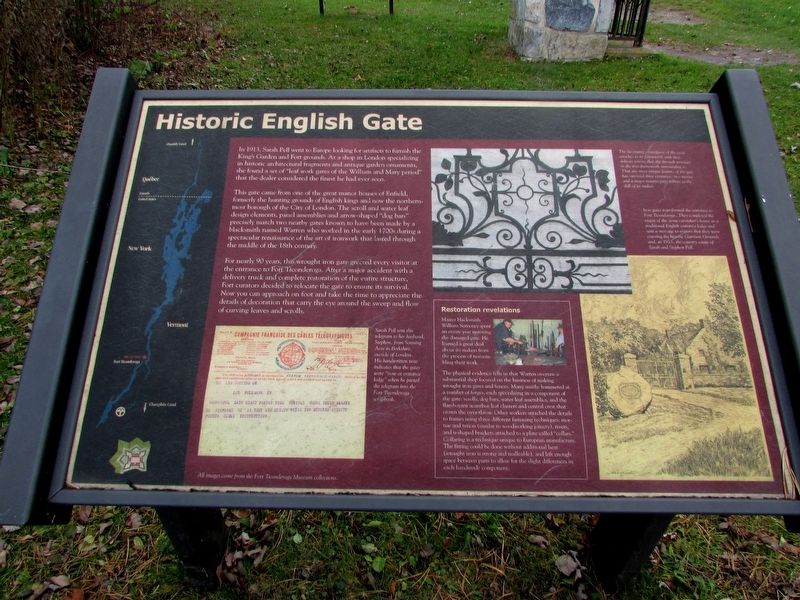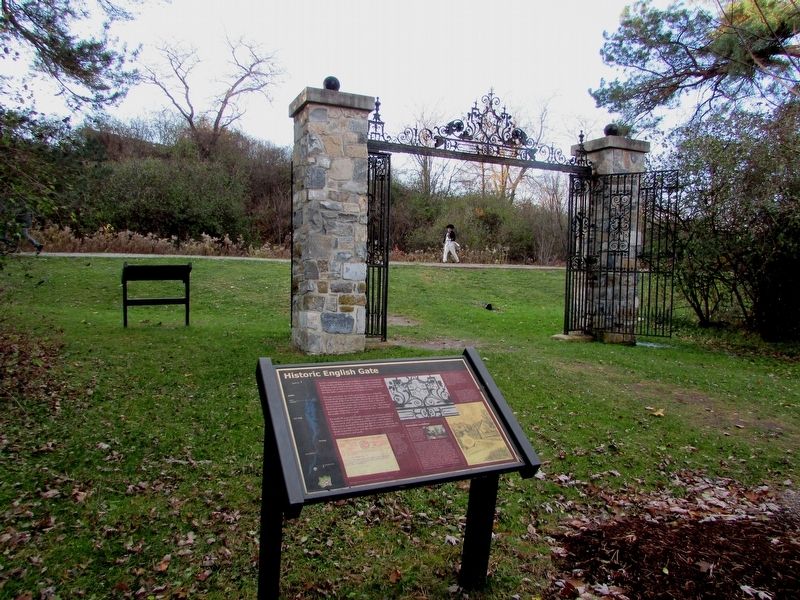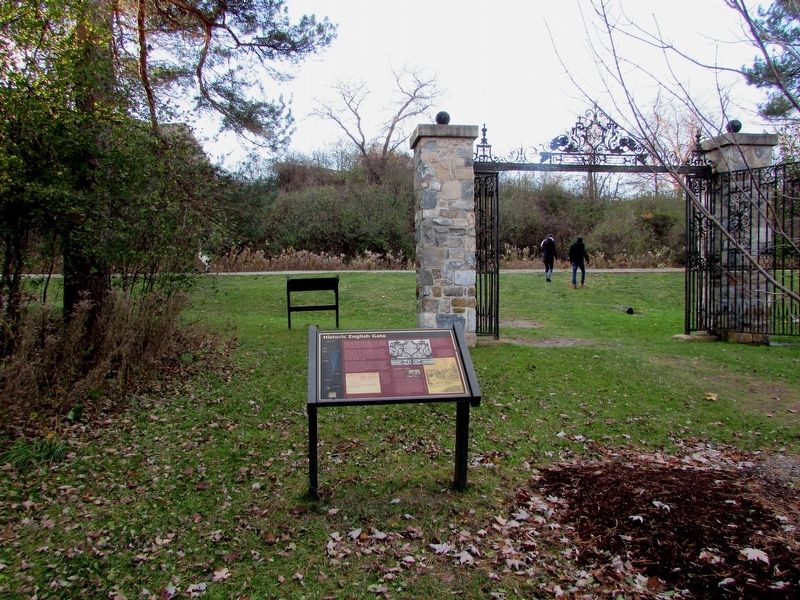Ticonderoga in Essex County, New York — The American Northeast (Mid-Atlantic)
Historic English Gate
In 1913, Sarah Pell went to Europe looking for artifacts to furnish the King’s Garden and Fort grounds. At a shop in London specializing in historic architectural fragments and antique garden ornaments, she found a set of “leaf work gates of the William and Mary period” that the dealer considered the finest he had ever seen.
This gate came from one of the great manor houses of Enfield, formerly the hunting grounds of English kings and now the northernmost borough of the City of London. The scroll and water leaf design elements, panel assemblies and arrow-shaped “dog bars” precisely match two nearby gates known to have been made by a blacksmith named Warren who worked in the early 1700s during a spectacular renaissance of the art of ironwork that lasted through the middle of the 18th century.
For nearly 90 years, this wrought iron gate greeted every visitor at the entrance to Fort Ticonderoga. After a major accident with a delivery truck and complete restoration of the entire structure, Fort curators decided to relocate the gate to ensure its survival. Now you can approach on foot and take the time to appreciate the details of decoration that carry the eye around the sweep and flow of curving leaves and scrolls.
Restoration revelations
Master blacksmith William Senseney spent an entire year restoring the damaged gate. He learned a great deal about its makers from the process of reassembling their work.
The physical evidence tells us that Warren oversaw a substantial shop focused on the business of making wrought iron gates and fences. Many smiths hammered at a number of forges, each specializing in a component of the gate scrolls, dog bars, water leaf assemblies, and the flamboyant acanthus leaf clusters and central crest that crown the over-throw. Other workers attached the details to frames using three different fastening techniques: mortise and tenon (similar to woodworking joinery), rivets, and u-shaped brackets attached to a plate called “collars.” Collaring is a technique unique to European manufacture. The fitting could be done without additional heat (wrought iron is strong and malleable), and left enough space between parts to allow for the slight differences in each handmade component.
Topics. This historical marker is listed in this topic list: Man-Made Features.
Location. 43° 50.518′ N, 73° 23.174′ W. Marker is in Ticonderoga, New York, in Essex County. Marker is on the grounds of Fort Ticonderoga, just inside the entrance to the King’s Garden. Touch for map. Marker is in this post office area: Ticonderoga NY 12883, United States of America. Touch for directions.
Other nearby markers. At least 8 other markers are within walking distance of this marker. A Layered Legacy (a few steps from this marker); French Bake Ovens, 1757 (within shouting distance of this marker); a different marker also named French Bake Ovens, 1757 (about 300 feet away, measured in a direct line); Magasin du Roi, 1756 (about 300 feet away); Lord & Burnham Estate Greenhouse (about 300 feet away); Breaking Ground (about 300 feet away); Preservation and Restoration at Ticonderoga (about 300 feet away); Gen. Henry Knox Trail (about 400 feet away). Touch for a list and map of all markers in Ticonderoga.
More about this marker. A photograph of a telegram at the lower left of the marker has a caption of “Sarah Pell sent this telegram to her husband, Stephen, from Sonning Acre in Berkshire, outside of London. His handwritten note indicates that the gates were ‘now at entrance lodge’ when he pasted the telegram into the Fort Ticonderoga scrapbook.
An image of details of the gate at the upper right of the marker includes a caption of “The decorative centerpiece of the crest attaches to its framework with very delicate patterns that slip through the iron framework surrounding it. That this most unique feature of the gate has survived three centuries is a tribute to the skill of its maker.”
A drawing of the gates in front of the Pell
estate appears at the bottom right of the marker and includes a caption of “Iron gates transformed the entrance to Fort Ticonderoga. They completed the vision of the stone caretaker’s house as a traditional English entrance lodge and sent a message to visitors that they were entering the historic Garrison Grounds and, in 1913, the country estate of Sarah and Stephen Pell.”
Credits. This page was last revised on November 14, 2018. It was originally submitted on November 14, 2018, by Bill Coughlin of Woodland Park, New Jersey. This page has been viewed 181 times since then and 14 times this year. Photos: 1, 2, 3. submitted on November 14, 2018, by Bill Coughlin of Woodland Park, New Jersey.


